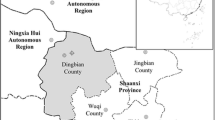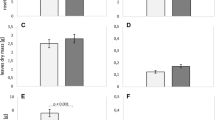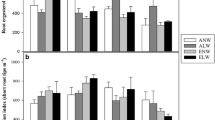Abstract
The effects of moisture availability on clonal growth and biomass investment in the bamboo Pleioblastus maculata were investigated over a four-year period by transplanting Pleioblastus maculata clones into soils with different levels of moisture availability in the field. The results showed that: (1) The higher the moisture availability, the greater the total biomass of P. maculata clones. Although fewer culms are produced at the higher moisture levels, mean tiller biomass is greater. (2) Under different levels of moisture availability, obvious differences in the total rhizome length (p < 0.01), spacer length (p < 0.05) and the sizes of bamboo culms (height, p < 0.01; diameter, p < 0.01) were observed. Thus, the higher the moisture availability, the shorter the rhizomes and the larger ramets. (3) In microhabitats with low moisture availability, bamboo allocated more biomass to underground organs, which promotes elongation of rhizomes and increases root production, thereby helping to capture underground resources essential to growth. In microhabitats of high moisture availability, the biomass is primarily allocated to the aboveground growth of ramets. (4) We suggest that soil moisture availability effects the foraging strategies of bamboo, that bamboo plants growing with low moisture availability produce longer rhizomes (that is, more, although shorter, spacers) with more biomass allocation than plants in high moisture and have a better ability to forage to increase the probability of locating adequate moisture patches. Also, longer length distance between shoots (that is, longer spacers) in high soil moisture than in low is adapted to avoid intense competition from faster growing aboveground growth in high moisture patches.
Similar content being viewed by others
References
Bell A.D. and Tomlinson P.B. 1980. Adaptive architecture in rhizomatous plants. Botanical Journal of the Linnean Society 80: 125–160.
Charpentier A., Mesleard F. and Thompson J.D. 1998. The effects of rhizome severing on the clonal growth and clonal architecture of Scirpus maritimus. Oikos 83: 107–116.
de Kroon H. and Knops J. 1990. Habitat exploration through morphological plasticity in two chalk grassland perennials. Oikos 59: 39–49.
de Kroon H. and Schieving F. 1991. Resource allocation pattern as a function of clonal morphology: a general model applied to foraging clonal plant. Journal of Ecology 79: 519–530.
Dong M. 1994. Foraging through morphological responses in clonal herbs. Utrecht University.
Dong M. 1999. Effects of severing rhizome on clonal growth in rhizomatous grass species Psammochloa villosa and Leymus secalinus. Acta Botanica Sinica 41: 194–198.
Lovett-Doust L. 1981. Population dynamics and local specialization in a clonal perennial (Ranunculus repens) I. The dynamics of ramets in contrasting habitats. Journal of Ecology 69: 743–755.
Lovett-Doust L. 1987. Population dynamics and local specialization in a clonal perennial (Ranunculus repens) III. Responses to light and nutrient supply. Journal of Ecology 75: 555–5685.
Headley A.D., Callaghan T.V. and Lee J.A. 1988. Water uptake and movement in the clonal plants, Lycopodium annotinum L. and Disphasiastrum companatum (L.) Holub. New Phytologist 110: 497–502.
Hutchings M.J. and de Kroon H. 1994. Foraging in plants: the role of morphological plasticity in resource acquisition. Advances in Ecological Research 25: 159–238.
Hutchings M.J. and Slade A.J. 1988. Morphological plasticity, foraging and intergration in clonal perennial herbs. pp. 83–109. In: Davy A.J., Hutchings M.J. and Watkinson A.R. (Eds.), Plant population ecology. Blackwell, Oxford, UK.
Huynh H. and Feldt L.S. 1970. Conditions under which mean square ratios in repeated measurements design have exact F-distributions. Journal of American Statistics Association 65: 1582–1589.
Li R. 1998. Clonal growth in the giant bamboo Phyllostachys pubescens. Universiteit Utrecht, Netherlands.
Liu Q. and Zhong Z.C. 1995a. Study on the energy structure of Pleioblastus maculata clone population. Journal of Yuzhou University (Natural Science) 12(3): 22–27.
Liu Q. and Zhong Z.C. 1995b. The demography of Pleioblastus maculata clone population. Journal of Southwest China Normal University (Natural Science) 202: 176–182.
Liu Q. and Zhong Z.C. 1995c. Advances in ecological research of clonal population and some related concepts. Chinese Journal of Ecology 14(3): 40–45.
Liu Y.C., Miao S.L., Li X.G. and Dong M. 1984. A brief account of the resources of vegetation of the Jinyun Mountain Nature Sanctuary, Sichuan province. Journal of Southwest China Normal University (Natural Science) 9: 117–129.
Schmid B. 1986. Spatial dynamics and integration within clonal of grassland perennials with different growth form. Proceedings of the Royal Society of London B228: 173–186.
Slade A.J. and Hutchings M.J. 1987a. The effects of nutrient availability on foraging in the clonal herb Glechoma hederacea. Journal of Ecology 75: 95–112.
Slade A.J. and Hutchings M.J. 1987b. The effects of light intensity on foraging in the clonal herb Glechoma hederacea. Journal of Ecology 75: 639–650.
Wang Y.S. and Li J.X. 1992. Patterns of clonal growth in Leymus chinensis population. Acta Phytoecologica et Geobotanica Sinica 16: 234–242.
Xiao J.H. 1983. Under-ground structure of bamboo groves cultivating for timber use. Bamboo Research 2: 114–119.
Zhong Z.C. 1995. Reproductive strategies of plant population. Chinese Journal of Ecology 14: 37–42.
Author information
Authors and Affiliations
Corresponding author
Rights and permissions
About this article
Cite this article
Qing, L., Yunxiang, L. & Zhangcheng, Z. Effects of moisture availability on clonal growth in bamboo Pleioblastus maculata . Plant Ecology 173, 107–113 (2004). https://doi.org/10.1023/B:VEGE.0000026334.40661.06
Issue Date:
DOI: https://doi.org/10.1023/B:VEGE.0000026334.40661.06




